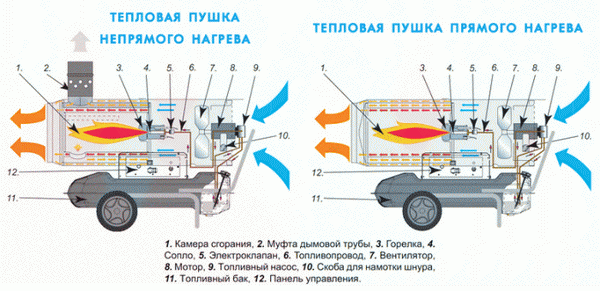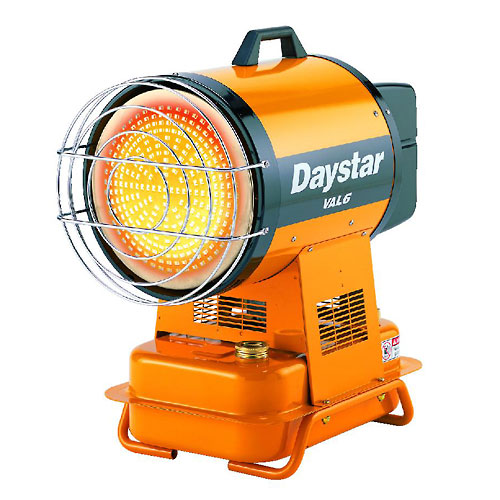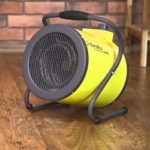The principle of operation of various types of diesel heat guns
If you need to heat the workshop (workshop, garage, cabins, hangar), or you cannot continue repairs in the winter due to low temperatures and high humidity in the building, or your car does not start during severe frosts, then diesel heat guns will become an indispensable thing in this business.
Content
General principle of operation
At its core, a heat gun is heat generator for space heating. In it, the air flow is heated by the combustion of liquid fuel. It consists of a cylinder with a built-in fan, a pump, a nozzle and a burner. At the bottom is the fuel tank. The principle of operation of a diesel heat gun is simple:
- from the tank using the pump fuel enters the nozzle;
- the combustible mixture starts to spread from the nozzle under pressure;
- fuel burns in the chamber;
- a fan pumps air through the cylinder;
- at the exit we get a stream of very hot air.
The heat gun on diesel fuel happens 2 types:
- Heat generator direct heating.
- Heat generator indirect heating.

Heat generator direct heating
Diesel heat gun direct heating is not equipped with a chimney and has the simplest design. Therefore, direct-flow heaters are inexpensive, compact, easy to use and their reliability. The ignition of the fuel occurs using a spark plug, in some models - from electric discharger. The heated air stream along with the exhaust gases enters the structure, which must be heated.
The use of such a heater is possible only in non-residential buildings with a good ventilation system or on construction sites (open).
Below shows the device diesel installation direct method of heating.

Heat generator indirect heating
The diesel heat gun of indirect heating is used in all cases, as direct flow. But due to the fact that gases are discharged to the outside, the range of its application is greatly expanded:
- in construction;
- agriculture;
- MES;
- in production workshops;
- for drying plaster (putty) during the cold season;
- heating concrete;
- drying facades during facing works;
- for warming trenches;
- heating greenhouses, farms in livestock;
- heating of residential premises and other things.
The design of diesel heat guns with exhaust gases contains a closed chamber in which the fuel is burned, and a chimney. Fuel is fed under pressure to the nozzle, in the chamber it is sprayed in the form of an aerosol and ignited. Air is blown into the unit by the fan. To maintain the combustion process through the holes located at the back, a part of the air penetrates into the chamber. The rest of the flow moves between the heater shell and the combustion chamber, where it is heated. Smoke comes out of the chamber through the chimney and is discharged outside, bypassing the room.
The use of such diesel heat guns is allowed for heating garages, rooms with people in them, pavilions.But in the process of the heater heats up oxygen, so you need provide airing to compensate for his loss.
Multi-fuel heat generators
The heat gun on liquid fuel can be multi-fuel. This means that the unit is able to work on waste oil, gasoline, diesel fuel, kerosene. Often this kind of heaters are used in places with a sufficient amount of petroleum products and their waste. These can be: fuel depots, car parks or service stations. This solves the problem of utilization of waste fuels and lubricants and heating is obtained free of charge.

The figure below shows the scheme of operation of a multi-fuel generator.

Diesel infrared guns
The liquid-fuel infrared heat gun heats rooms of large volume with high profitability and at the same time efficiency. It can also be successfully used outdoors. This kind of heat generator heats the objects themselves, towards which it is directed. Air heating comes from objects heated by the rays, and the height of the ceilings in the room does not play a significant role. Due to these characteristics, significant fuel savings are obtained.
Using this property, it is convenient to warm up objects in the open air.

How to choose a heat gun
Before you choose a heat gun, you should consider a few important points.
- Unit shape. Thermal fuel oil heaters may have a rectangular and cylindrical shape. Rectangular due to the large area of distribution of the air flow can be used as the best option during construction work indoors.

For point heating of objects or areas in a room, a cylindrical gun is more suitable.

- Mobility. Portable units are very easy to use, easy to carry, some models are equipped with trolleys. Stationary units are used for continuous space heating. When installing them, special installation work is required.

Stationary gun
- Heating method. Airflow can be heated directly or indirectly. This is important if the heater will be used in rooms with people or animals.
- Types of fuel used. The combustible mixture should be selected on the basis of specific situations and the rationality of its use.
- Noise Some heat guns (high power) on diesel fuel because of the great noise they make are not recommended for use in small rooms.
- Unit power. This parameter should be taken into account first of all before choosing a diesel heat gun. It depends on the quality of space heating or drying. Information about the power of the device can be found in the description to it.
Most heat guns have a handle. temperature control, with which you can customize the operation of the unit to a predetermined temperature in the room, after which it is turned off. The device does not turn on if the temperature on the board is lower than in the room. Also diesel heaters are equipped overheating protection system.
How is the power of the heat gun calculated
Thermal power of the device is calculated by the formula: V * T * K = kcal / h, where:
- V is the volume of the room (width * length * height), in m3;
- T is the difference between the temperature outside and indoors, in degrees Celsius;
- K is the coefficient of thermal dispersion.
For different types of premises, the coefficient values are set:
- from 3.0 to 4.0 - a room in which no thermal insulation is provided, for example,structure of wood or sheet metal;
- from 2.0 to 2.9 - a room with poor thermal insulation. A simple building with one brick;
- from 1.0 to 1.9 - a building with an average level of thermal insulation (laying in 2 bricks and several windows, standard roof);
- from 0.6 to 0.9 - the building with high quality thermal insulation. Brick construction with double insulation. Double glazed windows on the windows. Base under the floor of sufficient thickness. On the roof, for insulation, applied high quality material.
An example of calculating the power of a diesel heat gun:
- V = 150 m3;
- T = 29 ° С (external temperature is -10 ° С, it is required in the room + 19 ° С, the difference will be - + 29 ° С);
- K = 2 (one brick building);
Substitute the data in the formula: 150 * 29 * 2 = 8700 kcal / h, despite the fact that 1kWh = 860 kcal / h. So: 8700/860 = 10,116 kWh. Thus, we learned that to heat this building, a heat gun on liquid fuel with a minimum power of 10 kWh is required. It is recommended to buy a unit with some power reserve.
Advantages of diesel heat generators
When using diesel heat guns, several positive points can be identified:
- outstanding performance;
- ease of maintenance;
- power can reach up to 230 kW;
- highly low fuel consumption;
- autonomous work more than 10 hours;
- works well at low temperatures;
- the ability to quickly heat a large area.
Based on the above-mentioned positive aspects, it is safe to say that the heat trap is the most effective device for heating residential and industrial premises.

/rating_off.png)












